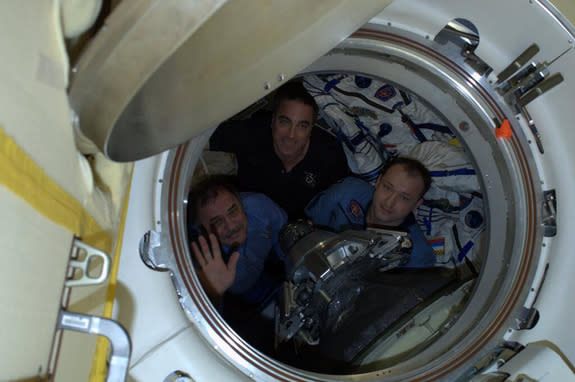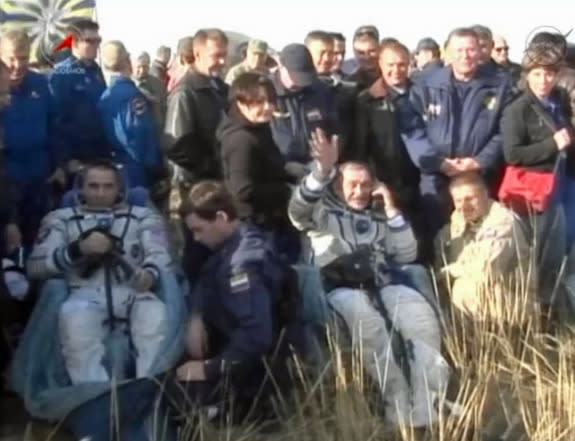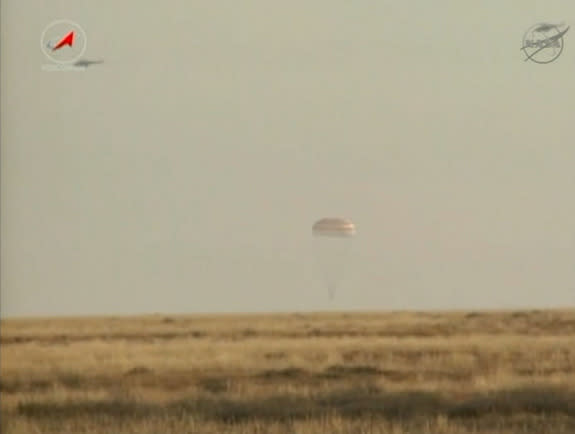Touchdown! US-Russian Crew Returns to Earth on Soyuz Space Capsule
A Russian Soyuz spacecraft has returned an American astronauts and two cosmonauts safely back to Earth, capping a five-month trek to the International Space Station.
The Soyuz TMA-08M space capsule carrying NASA astronaut Chris Cassidy and Russian cosmonauts Pavel Vinogradov and Alexander Misurkin touched down at 10:58 p.m. EDT Tuesday (0258 Sept. 11), though it was early Wednesday morning at their landing site on the steppes Kazakhstan in Central Asia.
All three men were reportedly in good spirits after spending 166 days in space, NASA spokesman Rob Navias said from the landing site. They landed in clear, warm weather, despite predictions of rain. [See Soyuz landing photos for the space station crew]
But it seemed clear even before the landing that the returning space travelers were looking forward to their return home.
"Okay, I'm thinking about coffee and apples," one of the Russian crewmates said as the Soyuz streaked back to Earth.
And the cosmonauts weren't the only ones eager to taste the culinary delights of Earth once more.
Before leaving the space station, Cassidy told reporters he would be sad to leave the orbiting lab behind, but at the same time he was excited to return home and see his wife and three children again.
In addition to rejoining his family, a "a gooey, fresh-baked chocolate chip cookie ranks right on the top of my list," Cassidy told CBS Radio in an interview broadcast on NASA TV.
Cassidy, Vinogradov and Misurkin launched to the International Space Station on March 28 and made history when they became the first crew ever to launch on an "express" one-day flight to the orbiting lab. Their successful flight set the bar for future Soyuz crew launches to the space station.
The three men formed half of the space station's Expedition 35 and 36 crews, with Vinogradov commanding the Expedition 37 portion of the mission. They performed several U.S. and Russian spacewalks during the flight, with Cassidy even taking part in an unplanned spacewalk to hunt for an ammonia leak in the space station's cooling system in May.
After landing, Cassidy, Vinogradov and Misurkin will undergo a battery of medical tests to check their health after the long-duration spaceflight. Cassidy will also participate in extra tests to serve as a baseline for his fellow NASA astronaut Scott Kelly, who is slated to launch on a one-year space station mission — twice as long as typical station stays — in 2015, NASA officials said. The test will also inform work on potential manned missions to Mars, they added.
This was the first spaceflight for Misurkin and the second for Cassidy, who ended the trip with a total of 181 days in space across the two flights. It was the third spaceflight for Vinogradov, who flew on a trip to the International Space Station and Russia's Mir station before this trip. He ended the flight with a total of 546 days in space.
With the safe return of the Soyuz crew, the Expedition 37 mission has officially begun on the space station. The crew includes Russian cosmonaut Fyodor Yurchikhin, NASA astronaut Karen Nyberg and Italian astronaut Luca Parmitano, with Yurchikhin commanding the team.
Nyberg snapped photos of her Earth-bound comrades as they left the space station. She even posted one image on Twitter, where she has been chronicling her spaceflight under the name @AstroKarenN.
"Saying goodbye to Pavel, Chris & Sasha," Nyberg wrote, referring to Misurkin by his nickname. "We'll miss them! Safe journey home."
Yurchikin, Nyberg and Parmitano arrived at the space station in May. They will be joined three new crewmates — Russian cosmonauts Oleg Kotov and Sergey Ryazanskiy and NASA astronaut Michael Hopkins — once that new crew launches on Sept. 25. The station crew is also preparing for the arrival later this month of the first unmanned cargo ship built by the commercial spaceflight company Orbital Sciences Corp., of Dulles, Va. The mission is slated to launch from NASA's Wallops Flight Facility on Wallops Island, Va., on Sept. 17.
The $100 billion International Space Station has been continuously manned by astronauts and cosmonauts since 2000. Construction of the orbiting laboratory began in 1998, with five different space agencies and 15 countries overseeing its assembly. It is the largest manmade structure in space.
Email Tariq Malik at tmalik@space.com or follow him @tariqjmalik and Google+. Follow us @Spacedotcom, Facebook and Google+. Original article on SPACE.com.
Copyright 2013 SPACE.com, a TechMediaNetwork company. All rights reserved. This material may not be published, broadcast, rewritten or redistributed.




